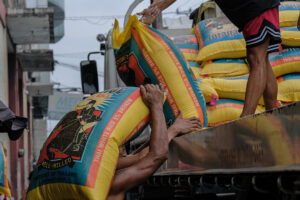By Luisa Maria Jacinta C. Jocson, Reporter
THE CONTINUED DECLINE in rice prices, which typically accounts for nearly half of overall inflation, is set to pave the way for further monetary easing, analysts said.
“With the price of the biggest staple in the Filipino consumer basket set to ease further, we think the door for the central bank to continue its measured easing cycle remains wide open,” Aris D. Dacanay, economist for ASEAN (Association of Southeast Asian Nations) at HSBC Global Research said.
“With low tariffs and the harvest season, rice prices in Metro Manila appear to be on a downtrend,” Metrobank Research said in a report.
The executive order slashing tariffs on rice imports, which took effect in July, has led to a decline in rice prices on a monthly basis.
President Ferdinand R. Marcos, Jr. ordered rice tariffs to be cut to 15% from 35% previously, until 2028.
At end-October, the average price of well-milled rice ranged from P43 to P54 per kilogram, lower than the P47-to-P55 range at end-September, data from the Agriculture department showed.
Meanwhile, regular milled rice cost P40-P50 per kilogram from P45-P50 per kilogram a month ago.
“Still, costs of the grain remain above their October 2023 levels. We expect annual rice inflation to be positive in October, though it should remain in the single digits due to a high base from a year ago,” Metrobank Research said.
Rice inflation sharply slowed to 5.7% in September from 14.7% in August and 17.9% a year ago. This also marked the lowest rice inflation since the 4.2% print in July 2023.
Headline inflation likely quickened to 2.4% in October from 1.9% in September, according to a BusinessWorld poll of 11 analysts conducted last week.
“We believe inflation quickened to 2.3% in October from 1.9% in September. We expect that the recent typhoons resulted in higher prices for key food items such as vegetables, fruits, and fish,” Philippine National Bank economist Alvin Joseph A. Arogo said in an e-mail.
Mr. Dacanay said that while base effects caused inflation to reaccelerate in October, overall, the headline print is seen to “have remained benign.”
“The biggest deflationary pressure was rice as global rice prices finally eased,” he added.
Chinabank Research said that inflation will likely continue to stay below 3% amid the lower rice tariffs and base effects.
“Looking ahead, we expect inflation to remain within target, barring any unexpected shocks… This favorable inflation outlook, combined with anticipated further rate cuts from the Fed, boosts the case for another rate cut by the BSP at its next policy meeting in December,” it added.
Bangko Sentral ng Pilipinas (BSP) Governor Eli M. Remolona, Jr. has said that the Monetary Board could possibly cut rates by another 25 basis points (bps) at its last meeting this year on Dec. 19.
The central bank has so far cut borrowing costs by a total of 50 bps since it began its easing cycle in August.
Mr. Remolona has also signaled further rate cuts next year, possibly by a total of 100 bps.
Metrobank Research also expects inflation to continue to settle within the 2-4% target band.
“Should price risks — from oil and other commodities amid geopolitical tensions and extreme weather disturbances — not materialize, Metrobank Research maintains that full-year headline inflation should remain within the BSP’s target,” it added.
On the other hand, Federation of Free Farmers National Manager Raul Q. Montemayor said that rice prices have not fallen fast enough even with the tariff cut.
“The reduction in prices for both regular and well-milled rice are far off initial expectations of a P6-7 fall in prices per kilo arising from the tariff cut,” he said in a Viber message.
“Clearly, the tariff reduction has not worked in reducing retail prices. In the meantime, tariff revenues have fallen together with palay prices.”
Mr. Montemayor said that retail prices normally fall during harvest months due to the added supply.
“But the recent typhoons could temper the reduction in retail prices because of their impact on supply,” he said.
“Imports continue to come in, but it seems that the importers and traders are keeping most of the tariff savings for themselves instead of passing it on to consumers,” he added.
The Department of Agriculture earlier said that palay (unmilled rice) production will likely decline by 3.24% this year amid crop losses due to adverse weather conditions.
